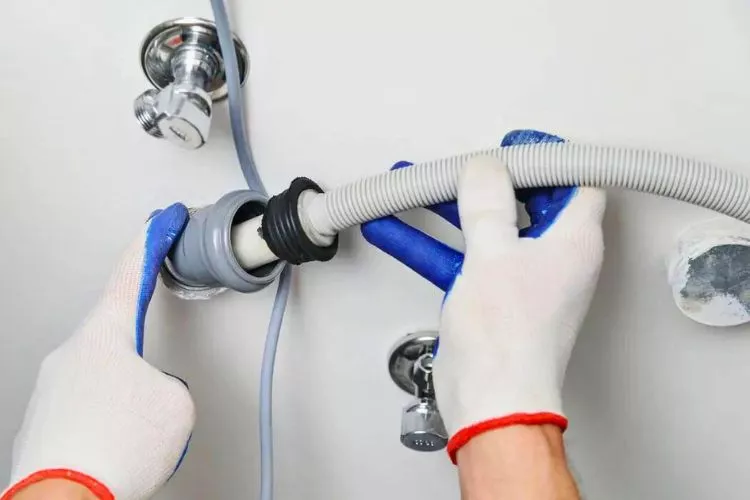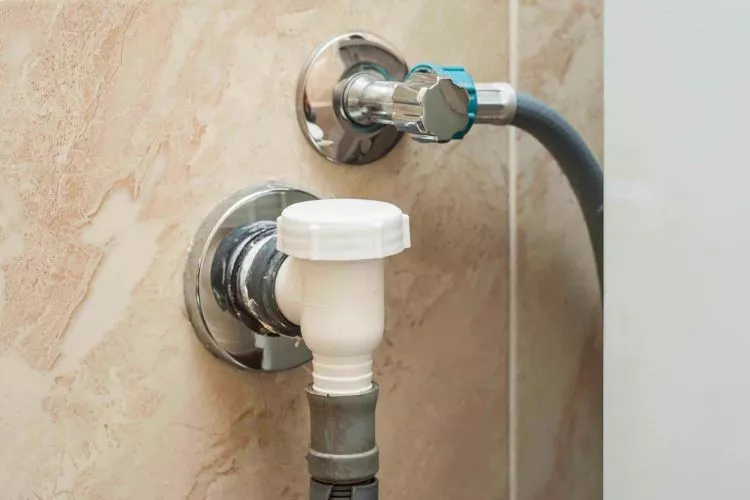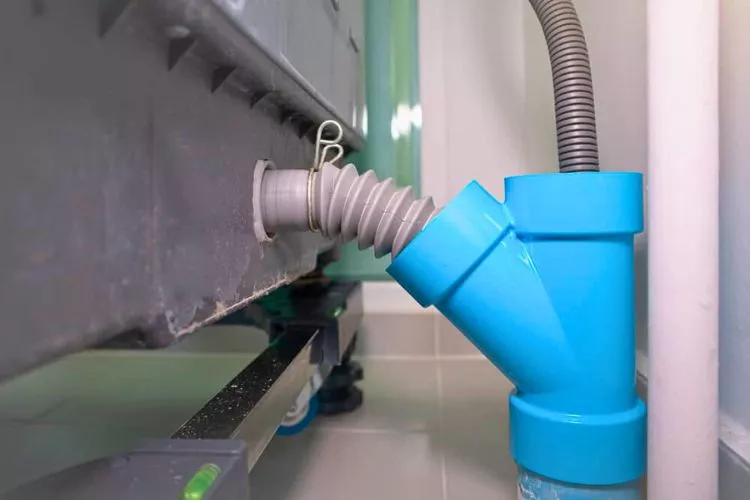An unexpected leak from your washing machine drain pipe, especially one hidden within your wall, can become a homeowner’s worst nightmare, often resulting in unseen damage.
This article aims to shed light on this surprisingly common yet alarming issue.
We delve into the cause of washing machine drain pipe leaking in wall, diagnostic methods, and practical solutions related to it, helping you make informed decisions and take appropriate action.

With handy guides, expert tips, and precautionary insights, arm yourself with the knowledge necessary to prevent or deal with such situations in the nexus of your home: the laundry room.
Washing machine drain pipe leaking in wall: 9 Possible Reasons
Take on these common reasons and change them. Find the right fix for your leak. Your laundry room will be dry and free from harm.

Pipe Blockage
The build-up of debris and lint in your washer’s drain pipe is a common issue. Over time, materials that get flushed down with the rinse water can accumulate within the pipe.
This accumulation forms a blockage. When the water can’t flow freely, it starts to back up. The backflow of water exerts pressure on the pipe and leads to leaks.
Age and Wear
Just like many other components in a property, pipes are not immune to age and wear. Over time, due to constant water flow and environmental factors such as humidity and temperature changes, pipes can split or crack.
These subtle yet gradual changes in the pipe’s structure are often the cause of sudden leaks.
Incorrect Installation
Installation is a crucial phase in setting up any appliance, and washing machines are no exception. Should the drain pipe not fit properly within the wall or if it’s done without adherence to established procedures, it can lead to undue stress on the connection points. This strain can eventually result in a drain pipe leakage.
High Water Pressure
Generally, washing machines are designed to withstand a certain level of water pressure. However, when this level is exceeded, it can lead to undue strain on the drain pipe.
This excessive force doesn’t only cause immediate leaks but also weakens the structure of the pipe over time. This weakness can escalate to bigger leaks and cause further damage if the pressure isn’t regulated.
Damaged Seals
Washing machine pipes usually have seals or washers at their joints to prevent water leaks. These seals, while durable, can still succumb to wear and tear over time, or get damaged due to hard water exposure or mechanical stress.
When these seals begin to deteriorate, they lose their ability to seal the joints properly, resulting in leaks from these points.
Pipe Material
The quality and type of material used in the drain pipe play an integral role in its longevity and performance. Cheaper, low-quality materials, or ones that are susceptible to rust, can lead to premature damage.
As these materials corrode, they develop small, porous holes. Water finds an easy escape through these corrosive points, resulting in leaks, and in some cases, can escalate to pipe burst if not attended to in a timely manner.
Temperature Fluctuations
Extreme temperature changes can have an adverse effect on the integrity of your washing machine’s drain pipe. As the temperature rises and falls, the pipe materials expand and contract, respectively.
This constant expansion and contraction can eventually weaken the pipe’s structure, making it more prone to leaks or even causing the pipe to crack.
Improper Venting
An efficient venting system is crucial for your washing machine’s drainage mechanism. An incorrectly installed vent or a clogged one can create a vacuum, restricting the water from flowing smoothly through the drain pipe.
The water can then overflow from the pipe, leading to leaks. Moreover, poor venting can cause airlocks, which might lead to a reduced draining speed or even a complete blockage.
Poor Craftsmanship
In some instances, the reason behind a leaking pipe could be due to manufacturing defects or errors in the washer’s drain pipe, connectors, or joints. These inherent flaws might make the pipe more vulnerable to leaks.
For example, if the pipe’s walls are thinner at some points or the joint has a minor crack, water can easily find its way out, leading to a leak. In order to tackle such issues, it’s important to use high-quality components and verify their longevity.
Solutions for Washing Machine Drain Pipe Leaks
1. Pipe Blockage
To address a blocked pipe, you can try the following steps:
- Use a drain snake or pipe brush to remove the accumulated debris from the pipe.
- Periodically use a drain cleaner solution suitable for washing machines to prevent future build-up.
- Regularly inspect and clean the lint filter if your machine has one.

2. Age and Wear
To mitigate issues related to age and wear, consider the following:
- Proactively inspect pipes for signs of corrosion, rust, or cracks.
- Replace older pipes with higher quality materials to improve longevity.
- Keep up with a regular maintenance schedule for your washing machine and its related plumbing.
3. Incorrect Installation
To fix installation-related issues, you can:
- Consult a professional plumber or technician to ensure proper installation.
- Follow the washing machine manufacturer’s guidelines to prevent misalignment or pipe damage.
- Ensure that the washing machine is level, and the drain pipe is positioned correctly.
4. High Water Pressure
To regulate high water pressure, consider these solutions:
- Install a pressure regulator on the main water line to maintain a consistent water pressure.
- Check your washing machine’s user manual for the recommended water pressure and adjust accordingly.
- Monitor the water pressure regularly to prevent future leaks.
5. Damaged Seals
To address damaged seals or washers, follow these steps:
- Inspect the seals at the pipe joints regularly for wear or damage, and replace them as needed.
- Apply plumber’s tape or sealant on the threads of the pipe joint to improve the seal.
- Ensure a proper fit between the drain pipe and washing machine connector to reduce stress on the seals.
6. Pipe Material
To tackle issues related to pipe material, you can:
- Replace the existing pipe with a higher-quality, corrosion-resistant material such as PVC or stainless steel.
- Opt for pipes that have anti-corrosive coating or lining for added protection.
- Inspect pipes regularly to spot early signs of corrosion and take timely action.
7. Temperature Fluctuations
To reduce the impact of temperature fluctuations, the following solutions can be considered:
- Insulate the drain pipe and surrounding area to minimize the effects of temperature changes.
- Monitor the temperature in the area where your washing machine is located and ensure it remains within the acceptable range specified by the manufacturer.
- Install a temperature control system in your laundry room to maintain a consistent temperature.
8. Improper Venting
To fix venting-related issues, you can:
- Consult a professional to inspect your venting system and ensure it meets local plumbing codes.
- Clear any clogs or obstructions in the vent system that might be affecting drainage.
- Regularly clean and maintain the vent system to ensure smooth operational flow.
9. Poor Craftsmanship
To resolve issues due to poor craftsmanship, you can:
- Purchase washing machines and parts from reputable brands known for their quality and reliability.
- Inspect new components for any visible defects before installation.
- Consult a professional technician or plumber when faced with issues related to the drain pipe, connectors, or joints.
Conclusion:
A washing machine drain pipe leaking within a wall can present a complex problem that requires quick detection and prompt resolution. The causes can be numerous, ranging from pipe blockage, age-related wear and tear, poor craftsmanship, to even improper installation.
This underscores the significance of quality materials, adept craftsmanship, and regular maintenance. Taking measures to prevent blockages, mitigate high water pressure, and address temperature fluctuations can help sustain the longevity of your appliance.
Remember, if you’re uncertain or overwhelmed, consider seeking professional help to ensure the issue is resolved accurately and safely.


